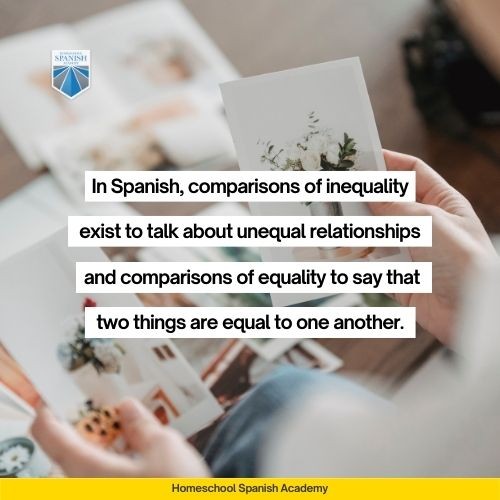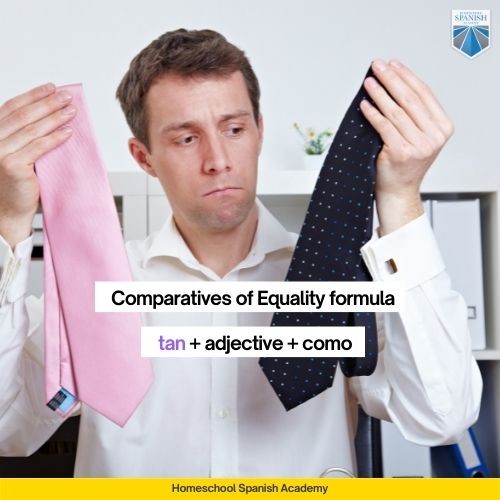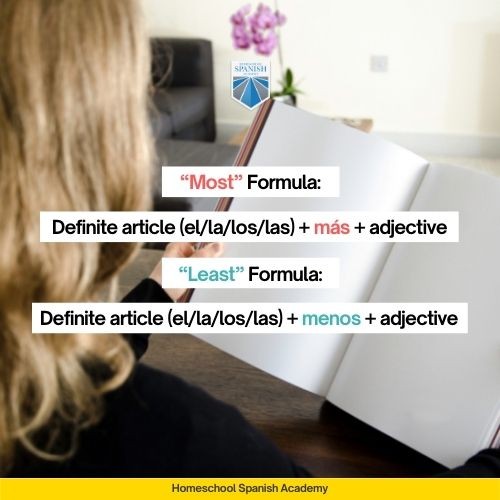Comparatives and superlatives are fundamental tools in any language, allowing us to express comparisons, degrees, and extremes. In Spanish, mastering comparatives and superlatives will significantly enhance your ability to describe and compare nouns, express opinions, and understand nuances in conversation and text. Are you wondering just how useful they are in Spanish? Let’s consider a few examples:
- ¿Puedes hablar más lentamente? (Can you speak more slowly?)
- Me gusta más ese. (I like that one more.)
- ¡Eres el mejor! (You’re the best!)
- Es la palabra más difícil de pronunciar. (It’s the most difficult word to pronounce!)
As you can see, comparatives and superlatives are far more common and essential than you might initially think. Learning how to use them correctly will not only make your Spanish sound more natural but also allow you to express yourself with greater precision and confidence.
Table of Contents:
Diving into Comparatives and Superlatives in Spanish
In Spanish grammar, comparatives are adjectives used to draw comparisons between two items. They help us highlight how two things are similar or different in terms of a particular quality. We categorize Spanish comparatives into two main types: comparisons of inequality, used to indicate when things are not equal, and comparisons of equality, used to express that two things are the same in some respect.
Superlatives take comparison a step further. They are used when you’re comparing three or more items and want to point out the one that possesses the highest or lowest degree of a certain characteristic. Essentially, superlatives identify “the most” or “the least” among a group.
Before we delve deeper into comparatives and superlatives, if you feel you need a quick refresher on adjectives in Spanish, you might find it helpful to review resources like “A Massive List of Spanish Adjectives and How To Use Them.” Understanding adjectives is crucial as they form the base for both comparative and superlative constructions.
Mastering Comparisons of Inequality
Comparisons of inequality in Spanish are used to show that one thing has either more or less of a quality than another. This is similar to using “more than” or “less than” in English.
In English, we form comparatives of inequality in a couple of ways: we either add “-er” to shorter adjectives (like “shorter”) or use “more” with longer adjectives (like “more beautiful”).
- Examples in English:
- My car is faster than yours.
- This book is more interesting than the last one.
Spanish simplifies this process. Regardless of the adjective’s length, you’ll use consistent formulas to express “more than” and “less than.”
Here are the formulas you need to know:
-
“More than” Formula:
más + adjective + que
-
“Less than” Formula:
menos + adjective + que
It’s crucial to remember that in Spanish, adjectives must agree in gender and number with the nouns they describe. This agreement rule applies to adjectives within comparative structures as well.
Let’s look at some examples to see these formulas in action:
- Mi casa es más grande que la tuya. (My house is bigger than yours.)
- Este libro es menos aburrido que el otro. (This book is less boring than the other one.)
- Él es más alto que su hermano. (He is taller than his brother.)
- Esta película es menos emocionante que la que vimos ayer. (This movie is less exciting than the one we saw yesterday.)
- Los estudiantes en esta clase son más inteligentes que en la otra. (The students in this class are more intelligent than in the other one.)
To express the opposite of equality, meaning something is “not as… as” something else, you’ll use a slightly different structure that incorporates negation. This construction uses the basic form of the adjective and follows this formula:
no + verb + tan + adjective + como
This formula effectively conveys that two things are not equally matched in a particular quality. Here are some examples illustrating its use:
- Este coche no es tan rápido como el deportivo. (This car is not as fast as the sports car.)
- Ella no es tan habladora como su hermana. (She is not as talkative as her sister.)
- El examen no fue tan difícil como esperaba. (The exam was not as difficult as I expected.)
- Estos zapatos no son tan cómodos como mis zapatillas de deporte. (These shoes are not as comfortable as my sneakers.)
Navigating Irregular Comparative Adjectives
While most comparative adjectives in Spanish are formed regularly with más and menos, there are a few important irregular forms. The good news is that these irregular forms are often simpler than the regular ones because they don’t require más or menos. You just need to memorize these specific comparative forms.
Key Irregular Comparatives
| Adjective | Comparative Irregular Form | English Equivalent |
|---|---|---|
| bueno/a (good) | mejor | better |
| malo/a (bad) | peor | worse |
| grande (big) | mayor | bigger, older |
| pequeño/a (small) | menor | smaller, younger |
| joven (young) | menor | younger |
| viejo/a (old) | mayor | older |





It’s worth noting that for grande, pequeño, joven, and viejo, you can also use the regular comparative forms (más grande, más pequeño, más joven, and más viejo). Both forms are correct and used, though the irregular forms mayor and menor are generally preferred when referring to age or rank, and often size in more formal contexts.
Irregular comparatives, unlike regular adjectives in comparative forms, do not change to agree in gender with the noun they modify. However, they still must agree in number.
Here are examples of irregular comparatives in sentences:
- Este restaurante es mejor que el de la semana pasada. (This restaurant is better than last week’s.)
- Su salud es peor ahora que antes. (His health is worse now than before.)
- Mi hermano mayor es más alto que yo. (My older brother is taller than me.)
- La casa nueva es menor en tamaño, pero más moderna. (The new house is smaller in size, but more modern.)
- Los estudiantes menores necesitan más atención. (The younger students need more attention.)
Further Exploration: For a more in-depth look at irregular comparatives, you might find the article “Irregular Comparatives in Spanish Adjectives and Adverbs” quite useful.
Expressing Comparisons of Equality
Comparisons of equality are used to indicate that two things are equal or the same in some quality. In English, we use “as… as” to express this. The Spanish equivalent primarily uses the word tan (so, as).
The basic formula for comparisons of equality with adjectives is:
tan + adjective + como
This structure directly translates to “as [adjective] as” in English. The adjective used with tan must agree in gender and number with the noun it describes, just like in other descriptive sentences.
Let’s see some examples of comparisons of equality:
- Ella es tan inteligente como su hermano. (She is as intelligent as her brother.)
- Estos zapatos son tan caros como los otros. (These shoes are as expensive as the others.)
- El libro es tan interesante como la película. (The book is as interesting as the movie.)
- Las clases online son tan efectivas como las presenciales. (Online classes are as effective as in-person classes.)
- Mi coche es tan viejo como el tuyo. (My car is as old as yours.)
Did you notice in these examples how the adjective following tan agrees with the noun being described? This agreement is essential for grammatical correctness in Spanish.
Expanding Your Knowledge: If you’re interested in learning more about the nuances between tan and tanto, which can sometimes be confusing, the article “Tan vs Tanto: What’s the Difference?” can provide valuable insights.
Another way to express comparisons of equality is by using the phrase igual de which means “just as.” The structure remains quite similar to using tan.
igual de + adjective + como
Using igual de instead of tan simply adds emphasis to the equality being expressed, making it clear that the two items are equally matched in the described quality.
- Ella es igual de trabajadora como su madre. (She is just as hardworking as her mother.)
- Estos dos modelos de teléfono son igual de buenos. (These two phone models are just as good.)
- La ciudad en verano es igual de hermosa como en primavera. (The city in summer is just as beautiful as in spring.)
Superlatives in Spanish: Expressing the Extreme
Superlative adjectives are used to compare three or more nouns and identify which one is “the most” or “the least” in terms of a particular quality. They express the highest or lowest degree of something within a group.
The structure for forming superlatives in Spanish is quite similar to comparatives, but with the addition of a definite article (el, la, los, las). The definite article is crucial as it specifies “the” most or “the” least.
Here are the formulas for forming superlatives:
-
“The Most” Formula:
Definite article (el/la/los/las) + más + adjective
-
“The Least” Formula:
Definite article (el/la/los/las) + menos + adjective
Remember, both the definite article and the adjective must agree in gender and number with the noun they are describing. This agreement is a key aspect of Spanish grammar and is essential for using superlatives correctly.
Let’s look at some examples of superlatives in sentences:
- Este es el libro más interesante de todos. (This is the most interesting book of all.)
- Ella es la persona más amable que conozco. (She is the nicest person I know.)
- Estos son los zapatos más cómodos en la tienda. (These are the most comfortable shoes in the store.)
- Ese restaurante es el menos caro de la ciudad. (That restaurant is the least expensive in the city.)
- De todas mis amigas, ella es la más alta. (Of all my friends, she is the tallest.)
As you can see, the definite article (el, la, los, las) and the adjective both adapt to match the gender and number of the noun being described, ensuring grammatical accuracy.
Irregular Superlatives in Spanish: Special Forms
Just as with comparatives, some adjectives have irregular superlative forms in Spanish. These irregular superlatives correspond to the same adjectives that have irregular comparative forms. The good news is that the superlative irregular forms are simply the irregular comparative forms with a definite article placed before them.
The formula to use irregular superlatives is:
Definite article (el/la/los/las) + superlative irregular adjective
Chart of Irregular Superlatives
| Adjective | Superlative Irregular Form | English Equivalent |
|---|---|---|
| bueno/a (good) | el/la mejor, los/las mejores | the best |
| malo/a (bad) | el/la peor, los/las peores | the worst |
| grande (big) | el/la mayor, los/las mayores | the biggest, the oldest |
| pequeño/a (small) | el/la menor, los/las menores | the smallest, the youngest |
| joven (young) | el/la menor, los/las menores | the youngest |
| viejo/a (old) | el/la mayor, los/las mayores | the oldest |
Similar to comparatives, you can also use the regular superlative forms with grande, pequeño, joven, and viejo (el más grande, la más pequeña, el más joven, los más viejos). Both are correct, but the irregular forms are frequently used, especially when referring to age or significance.
Irregular superlatives must also agree in gender and number with the noun they modify. This agreement applies to both the definite article and the irregular superlative adjective.
Here are some examples using irregular superlatives:
- Este es el mejor restaurante de la ciudad. (This is the best restaurant in town.)
- Fue el peor día de mi vida. (It was the worst day of my life.)
- Mi hermano es el mayor de todos mis primos. (My brother is the oldest of all my cousins.)
- Ella es la menor de sus hermanas. (She is the youngest of her sisters.)
- Estos son los mejores zapatos para correr. (These are the best shoes for running.)
Lo Mejor and Lo Peor: Gender-Neutral Superlatives
You’ll often hear the superlative forms mejor and peor used with the gender-neutral article lo. This construction, lo mejor and lo peor, is used to express “the best thing” or “the worst thing” in a general, non-specific way, without referring to a particular noun.
Spanish speakers use lo mejor or lo peor to talk about something being the best or worst of all possible things in a general sense.
- Lo mejor de viajar es conocer gente nueva. (The best thing about traveling is meeting new people.)
- Es lo peor que me ha pasado en este trabajo. (It’s the worst thing that has happened to me in this job.)
- No tener que madrugar los fines de semana es lo mejor. (Not having to get up early on weekends is the best thing.)
The lo article can also be used with other adjectives to express a general superlative quality, particularly when the reference is something abstract or gender-neutral.
- Es lo más fácil del mundo. (It’s the easiest thing in the world / It’s the easiest thing ever.)
- Lo más importante es la salud. (The most important thing is health.)
Other Ways to Express Superlatives: The -ísimo Suffix
Spanish offers another powerful way to express the extreme degree of an adjective: by adding the suffix -ísimo (or -ísima, -ísimos, -ísimas to agree in gender and number). This suffix intensifies the adjective, translating roughly to English words like “very,” “extremely,” “super,” or “incredibly.”
- ¡Qué guapísima estás! (You look absolutely gorgeous! / How very beautiful you are!)
- Este café está riquísimo. (This coffee is incredibly delicious. / This coffee is so delicious!)
There are a few spelling adjustments to note when adding -ísimo:
-
Adjectives ending in -ble change the ending to -bil before adding -ísimo.
- amable (kind) → amabilísimo (extremely kind)
- notable (notable) → notabilísimo (extremely notable)
-
Adjectives ending in -n, -dor, or -or often change -ísimo to -císimo.
- joven (young) → jovencísimo (very young)
- hablador (talkative) → habladorcísimo (extremely talkative)
- trabajador (hardworking) → trabajadorcísimo (extremely hardworking)
-
Many adjectives with an r in the final syllable may use the ending -érrimo instead of -ísimo, particularly in more formal or literary contexts.
- libre (free) → libérrimo (extremely free)
- pobre (poor) → paupérrimo (extremely poor)
- célebre (famous) → celebérrimo (extremely famous)
While -ísimo and its variations are powerful tools for emphasis, they are generally less common in formal writing compared to using muy (very) or the superlative structures with más. However, they are very common in spoken Spanish and informal writing to add expressiveness.
Comparatives and Superlatives in Spanish – Key Takeaways
To summarize, here are the essential points to remember about comparatives and superlatives in Spanish:
- Use más + adjective + que to say something is “more… than” something else.
- Use menos + adjective + que to say something is “less… than” something else.
- Use tan + adjective + como to say something is “as… as” something else.
- For superlatives (“the most” or “the least”), add a definite article (el, la, los, las) before más or menos and the adjective.
- Be aware of irregular comparative and superlative forms for adjectives like bueno, malo, grande, pequeño, joven, and viejo.
- Use the suffixes -ísimo, -císimo, and -érrimo to express an extreme degree of an adjective, equivalent to “very” or “extremely.”
- Always ensure adjective and article agreement in gender and number with the nouns they modify.
Practice Makes Perfect: Using Spanish Comparatives and Superlatives
Hopefully, you now see that comparatives and superlatives in Spanish are indeed quite straightforward, más fácil de lo que pensabas (easier than you thought). However, like any grammar topic, mastering them requires practice to solidify your understanding and usage in your long-term memory.
Think about what motivates you to learn Spanish. Is it the desire to travel to Spanish-speaking countries, to connect with native Spanish speakers, or to enjoy Spanish literature and films in their original language? In the U.S. alone, there are approximately 41 million native Spanish speakers, making Spanish incredibly relevant and useful in everyday life.
Why not start practicing today? Consider taking advantage of resources like Homeschool Spanish Academy, which offers free trial classes. Learning with native Spanish-speaking teachers can provide invaluable practice in using comparatives and superlatives in real conversations, helping you to achieve your fluency goals faster. Explore their pricing and programs to find a learning path that suits you best!
Join Our Community and See Real Results
Each month, we conduct 40,000 classes, helping students like you achieve their Spanish learning goals. Hear from some of our satisfied learners:
“Getting to know wonderful teachers who care about me and my growth in language and education. Evelyn Gomez and Erick Cacao are two of the most extraordinary people I have ever met, and talking with them in Spanish at the beginning of classes is always so fulfilling and greatly contributes to my happiness, joy, and wellbeing.”
– Abby
“HSA offers very affordable, quality, one on one classes with a native speaker. My son has greatly benefited from taking classes. We have seen his confidence increase as well as his pronunciation improve, because he learns from a native Spanish speaker. HSA has quick, personal customer service. Our family has been very pleased with our experience so far!”
– Erica P. Parent of 1
“It’s great being able to interact with native speaking people and having a conversation with them not just doing all the work on paper. It’s also an amazing opportunity to speak with native Spanish-speaking people without having to travel to a native Spanish-speaking country.”
– Melanie
Ready to Explore More Spanish Grammar?
Continue your Spanish grammar journey with these helpful articles:
Olga Put
Freelance Writer at Homeschool Spanish Academy
I’m a Spanish philologist, teacher, and freelance writer with a Master’s degree in Humanities from Madrid. I speak Polish, Spanish, and English fluently, and want to get better in Portuguese and German. A lover of literature, and Mexican spicy cuisine, I’ve lived in Poland, Spain, and Mexico and I’m currently living and teaching in Madeira, Portugal.
Latest posts by Olga Put (see all)
comparison grammar spanish grammar superlatives in spanish
0
